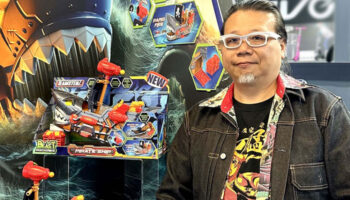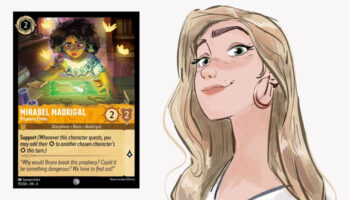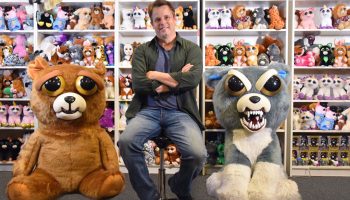Coyote & Crow designer Connor Alexander on representation, world-building and the little details that help create immersive RPGs

Coyote and Crow is a tabletop role playing game set in an alternate future of the Americas where colonisation never occurred.
The game has been created and led by a team of Native Americans representing more than a dozen tribes, including the creator of the game, Connor Alexander – a citizen of the Cherokee Nation.
We caught up with Connor to learn more about how he built the world of Coyote & Crow – and what he thinks of how the industry is tackling issues of representation.

Before we dive into Coyote & Crow, what’s your history in the games space?
I jumped into the gaming thing in the late Seventies/early Eighties playing D&D. Like a lot of us who were passionate about gaming, I’d toyed with the idea of making my own game at some point, but I didn’t consider it seriously until I started working in the industry.
Back in 2014, I started out managing a hobby games store and in 2016 I was offered a job working for PSI – Publisher Servicers Inc. It’s a middle-tier sales and distribution turn-key solution for the toy and games industry. We sell to mom-and-pop hobby shops through distributors like Alliance and ACD, but we also sell to Target and Barnes & Noble and represent around 140 vendors right now.
Working as an account manager and seeing the design process from this end made two things very clear to me. One, I felt like I had something to say in the design space, more than I had realised. Once I understood the process, I started to see the gaps and see things that weren’t being addressed.
The second thing was, as someone who really wants to create a more diverse and balanced game industry, I was starting to see a lot of systemic issues around the lack of diversity in the industry.
I’m fortunate enough that for most of my life I’ve passed for a normal white dude, and I’ve had all of those benefits. One of the biggest gaps I saw was a lack of representation for Native Americans and I’m a citizen of the Cherokee Nation, but I’d never considered pairing those two parts of my life up.
After speaking to a consultant friend of mine, who is Native American and works in representation in the games industry, they told me that even when the games industry gets representation right, it’s almost always through a colonial lens.
That’s when I started considering how I could use the advantages I have with my position and experience within the industry to bring something new to RPGs, which is one of my favourite types of games. That was back in 2018.
Amazing – and the result of that process is Coyote & Crow, a new sci-fi RPG set in an uncolonized future. It’s on Kickstarter doing incredibly well; how would you describe the game?
The elevator pitch is that it’s set in an alternate timeline where our histories diverged more than 700 years in the past. There was a climate changing event that altered the course of history, and the Americas never became colonised. Now, 700 years later, you play as the people living on these continents who are an advanced civilisation. The world is repairing itself and healing after this climate disaster, the weather is becoming more hospitable and you’re playing as characters who are in this broadening world with amazing technology.
There’s mysteries, science-fiction, fantasy and it’s a chance for Native Americans to see themselves in a totally different light and in a way that they’ve never been portrayed before.

Where do you begin to start when developing an RPG, because you’re essentially building a world right?
It all started with this question: How do I create a game world that is disentangled from elements of colonialism? It turned out to be a lot harder than I thought it would be. There’s so much of modern Native American culture that is a response to colonialism. There are hundreds of years of colonialism to untangle. That’s partly why I had to set the fracture in our timelines so far in the past.
Where that plays into my strengths as someone who has played a lot of RPGs over the years and has done a fair amount of creative writing, is that I’m fairly adept at creating new worlds. What took me a long time was the research that went into making sure I wasn’t creating any internal inconsistencies. There were a lot of opportunities for that… Once you create an alternate world, you need to have an internal logic that works throughout it.
We also have a few fantasy elements, which I love, but they had to accomplish a few goals. They had to never patronise the Native Americans – you don’t want anybody saying that the fantasy element saved the Natives and without it they’d all be dead.
You also want to be careful about feeding into stereotypes that exist in our real world, like ‘the noble savage’ or ideas around a utopia. You don’t want people to think I’ve created a world full of rainbows and unicorns just because colonialism didn’t happen… There’s still got to be challenges and a reason to role-play these characters. There has to be adventure, excitement and intrigue.
Classic D&D to me is all about: Go over there, explore that place you haven’t seen before, kill everything there, take stuff – and based on how much stuff you take, that’s how you advance in power. That’s the opposite of what I wanted from a Native American storytelling game. Undoing all of that was a calculated process that took a lot of imagination and research.

And the team behind the game is an all-Native team?
Well when I first started working on this, I drew a line in the sand and said everybody working on this game is going to be Native. That was my original goal.
The problem is that the systemic issues in the industry are such that getting in touch with those Natives is a very small Venn diagram – do they have experience in the games industry? Are they available to work on the project? Are they Native? It’s a small number of people and because we’re not all connected, it was tough to track them down.
Most of my team who are Native I found through sources like Twitter, Craigslist, ArtStation – I went everywhere looking for people. And most of these people are not from the industry at all.
Along the road, I made the decision that anyone who has a creative writing title in this world has to be Native. I didn’t want anybody writing creative content for the game that wasn’t Native. We have a few artists and an editor who aren’t Native, but the creative writing positions are taken by Natives.
I’d imagine that being more inclusive when it comes to themes can help grow the audience for RPGs too?
Yes, and we’re at a critical moment now. Role-playing games are a ridiculously small portion of the overall hobby games industry, and a massive portion of that is D&D. But it’s on the cusp of really changing. There are a lot of fresh voices out there and what’s really helped is that I don’t just see the change happening in RPGs… It’s happening in tabletop games too.
People don’t just want mechanics anymore; they want theme. As we start seeing better themes attached to board games, it’s bringing people closer to RPGs in a way that they’re comfortable with and the idea of telling stories around a table speaks across all cultures.

Coyote & Crow has done incredibly well on Kickstarter – raising over $680k. Does this help prove there is an audience here that’s been underserved and poorly represented by the tabletop space thus far?
Our original goal was $18,000, hoping that we might reach the $30k range. Before we launched, my partner asked me what my definition of success would be and I said to break even and have at least one Native American person walk up to me at a convention and say they loved the game. I’d feel like I’ve put something good back into the universe.
The response now is amazing. Daily I’m hit with messages from Natives – and non-Natives – who tell me, “I never thought I would see a game like this. Thank you for doing this.” It’s been humbling.
I got somewhat lucky because the timing of the launch has been perfect. NBC’s Rutherford Falls has an all-Native writing team and there’s a Netflix show called Spirit Rangers coming soon that has an all-Native writing team. There’s a moment now where people are recognising that Native Americans are still here, we still have vibrant cultures and have a lot of things to say.
Looking across RPGs and the tabletop space, do you think it’s starting to embrace more diverse themes and representation? And who should be pushing and provoking change in this way – publishers? Designers? The people running conventions? All of us?
I have to give props to people like Eric Lang and Suzanne Sheldon. They’re doing a lot of emotional labour and work that they don’t have to do – and shouldn’t have to do – but they’re sounding the alarm. That’s great and I adore them for doing it, but quite frankly, the responsibility at this point is with the owners and publishers of these smaller companies, who are primarily white guys.
The bad examples that we still see coming through are mind-boggling. I’ll see a game with a Central American theme or an Innuit theme, and you can tell that someone’s designed a mechanic, then they got an artist, then they put the theme on and then they went to someone from that culture and said “Is this okay?” We’re way beyond any excuses for that at this point.
Good game design – and by that I don’t just mean the quality of the game, I mean profitable game design – would’ve started with somebody from that culture. A publisher should approach someone and say “I have these mechanics; how can we add your culture to this game in a way that properly reflects your values, your background and your story? Can I bring you in as a game dev on this?”
It makes good business sense as well as being the right thing to do. But what’s remarkable is that I keep seeing publishers making the wrong decisions. They keep getting called out for it but then they keep doing it – and they see their peers doing it, getting ripped for it, and yet they still continue doing it themselves! It’s tone-deaf.
That said, I do think we’re getting better and we are at a point where people are starting to listen.
Absolutely. Now, back to Coyote & Crow, the nature of designing an RPG is that you’ll be handing this game to thousands of people who will be exploring different corners of it. Some campaigns you’d expect, some you might not! When building the world for an RPG, how do you make it expansive enough that players can tell their own stories within it, but not so detailed that they feel constrained?
You don’t want to box folks in. I use the sandbox analogy – I’m in charge of building the frame and filling the sandbox, but everyone else should be able to come in and create their own sandcastles.
It’s a tough balancing act because, in Coyote & Crow, I don’t want to tell someone from another tribe – or even my own tribe – how their alternate future is played out. I want them to tell me! Once people have this game in their hands, I want someone from the Hopi Nation to tell me about the cool things that happened to their tribe in this world. That would really excite me.
To create that scenario, we had to abstract and generalise things a lot, but there is a danger that you generalise too much and it becomes hard for people to visualise the world you’re creating. There’s a few key things that help people fill in their imaginations when you’re in this kind of world, and they are food, music, language and technology. If you fill those in, other things like education and government, filter in around those key aspects.

That makes total sense. Let’s dive into one of those, like food for example… How did you tackle that aspect for Coyote & Crow?
I started thinking about when you remove all the colonial elements and you start looking at traditional Native food sources, what would that say about the future? I started thinking about corn, and the value of corn. Even now in our real world, we have the potential to create bioplastics from corn. That led me to think that if Natives were on top of corn production in this country, we maybe could have developed corn into a synthetic plastic even earlier!
When it came to food, I realised I didn’t have all the answers, so we brought in an award-winning Cherokee chef. She rewrote my section on food and how these people would do their farming. She also created a fictional restaurant menu for an in-game place called The White Raven. As well as the menu, it also goes into how you would eat there and what the experience would be like.
Those little things really help people get immersed. You can create stats for a weapon or a bunch of sci-fi toys, but I don’t think they help human beings get immersed in these kinds of worlds. A great parallel example is Star Wars – it wasn’t the lightsaber that helped you connect with the characters. It was Luke’s experience with that lightsaber. You have to humanise these worlds.
Yes! The cantina in Star Wars does that too! It’s a recognisable, alien space… Now, looking ahead, have you got plans to explore this world in other ways? Maybe through card games or a TV show?
Well, the reason I chose an RPG was that it was the easiest format to long-form explain this world in a way that allowed me to dive into the depths of the setting. But I already have an idea for a complex strategy board game and a living card game, both set in this world.
I’m certainly open to other forms of media, print and digital. And we’ve had a few people already starting to ask.
That’s always a good sign!
Yes, I definitely feel like there’s some meat on the bones there for Coyote & Crow to become a brand. My role is now slipping away from game designer and into IP management and world building across different mediums. There’s a significant amount of potential there.
Finally, before I let you go, how do you fuel your creativity?
Even though I grew up on sci-fi and fantasy, since the pandemic hit, what’s been fuelling my creativity is reading a lot of non-fiction. I’ve been reading alternative perspectives on history and the idea of ‘what if’ has sparked lots of thoughts around that. It’s sparked some huge creative jumps for me and wasn’t really planned. I’d just picked up some books as part of research for Coyote & Crow, but it’s been a fun discovery.
That’s also a big shame about winners writing the history books; there are inspirational stories that get covered up along the way.
Well a huge thanks for this Connor and congrats again on the success of Coyote & Crow – I look forward to playing the game enjoying the brand as it soars! And folks can check out the Kickstarter campaign for the game here.
—-
To stay in the loop with the latest news, interviews and features from the world of toy and game design, sign up to our weekly newsletter here
























